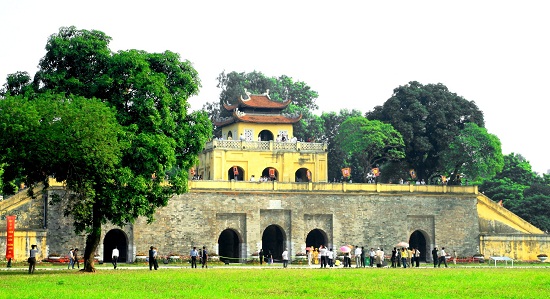Visitors can visit the ancient citadel of Hanoi, a structure bearing the impression of ancient Vietnam. Attract many tourists in the country and internationally.
Historical stamp
Formerly in 1010, King Ly Thai To moved the capital from Hoa Lu to Thang Long, the citadel was built and expanded in the dynasty after. Thang Long Citadel was planned as "Tam three citadel" with three rings into the nest. Forbidden city, or Long Phuong into the Ly - Tran in the same area, the royal palace. The central citadel covers the urban economic area in the east. In the end is La La or Dai La. In 1805, the Nguyen Dynasty built Hanoi to retain the Forbidden City as a palace for the king. In France, they kept this area as the military commander.
Architectural works
Five ancient architectural works survived after the French invasion of Hanoi, from the south to the north, including the following items: flag tower, Doan Mon Gate, Kinh Thien, Hau Lau and Bac Mon main gate.
The Doan Mon Gate is the only one retained in its entirety, including a two storeyed staircase, and an eight-storeyed upper floor with a five-door entrance. Above the main entrance, the male side of the word "Doan Men" is still relatively intact.
The Glass Tower was demolished in 1886 to house the artillery command post. There are only stone steps with two drag railing stone in the middle, two rows of stone carvings carved in the south, the north also has a decorative stone dragon threshold. There are 10 levels in the south of the tower, the north face is seven degrees by the large stones.
Late Lau, also called Princess Floor, built of brick, below the box, on the three-storey structure. The lower floor has three floors, the upper floor is two floors.

Bac Mon, trapezoid shape with two sides are triangular, heart shape rolls built of brick, rectangular stone embankment, edge fringed stone decorated lotus base. In the north, there is a stone sign written in Chinese characters "Main Bac Mon". Also on the right was a plaque engraved on April 25, 1882, and two cannon bullets - traces of the war with France. The gate was still, Vong Lau was on the gate of the city was destroyed. The city has rebuilt Vong Lau to restore its original appearance, maturity.
Five monuments on the architectural scale is not large, but with the relics lying underground to prove a political center, the capital of the country for nearly a thousand years of history.